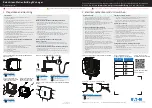
Inserting 1.2 V Nimh/NiCd AA or AAA batteries
e)
Slide the lower part of the product backwards and hold it with one hand.
1.
Insert one or two 1.2 V NiMH/NiCd AA or AAA batteries, observing the correct polarity.
2.
Release the lower part of the product to lock the batteries.
3.
ChARGING REChARGEABLE BATTERIES
Insert the batteries observing the correct polarity.
1.
Connect the product to the mains socket using the power plug, or to a cigarette lighter socket
2.
using the in-car adaptor.
The green LED and red LED indicate the status.
3.
green LED
red LED
off
off
No, or too little voltage present.
flashes
on
Charging.
on
on
Battery is charged.
off
on
Supply voltage present.
•
Battery incorrectly inserted or not properly connected to
•
contacts.
flashes
flashes
Charging ended automatically after 11 hours.
•
Batteries could not be fully charged.
•
Batteries faulty.
•
Error: Remove all batteries and commence charging
•
anew.
REPLACING ThE fUSE
Unscrew the cover cap of the in-car adaptor.
1.
Remove the fuse and replace it with a fuse of the same type. (F 2A L 250 V)
2.
Then screw the cover cap onto the in-car adaptor again.
3.
DISPOSAL
Product
a)
Electronic devices are recyclable waste and must not be disposed of in the household
waste.
At the end of its service life, dispose of the product according to the relevant statutory
regulations.
Remove any inserted rechargeable batteries and dispose of them separately from
the product.
Rechargeable batteries
b)
You as the end user are required by law (Battery Ordinance) to return all used batteries/
rechargeable batteries. Disposing of them in the household waste is prohibited.
Contaminated rechargeable batteries are labelled with this symbol to indicate that
disposal in the domestic waste is forbidden. The designations for the heavy metals
involved are: Cd = Cadmium, Hg = Mercury, Pb = Lead (name on rechargeable
batteries, e.g. below the trash icon on the left).
Used rechargeable batteries can be returned to collection points in your municipality,
our stores or wherever rechargeable batteries are sold.
You thus fulfil your statutory obligations and contribute to the protection of the environment.
Legal notice
These operating instructions are a publication by Voltcraft®, Lindenweg 15, D-92242 Hirschau/Germany, Phone +49 180/586 582 7
(www.voltcraft.de).
All rights including translation reserved. Reproduction by any method, e.g. photocopy, microfilming, or the capture in electronic data processing
systems require the prior written approval by the editor. Reprinting, also in part, is prohibited.
These operating instructions represent the technical status at the time of printing. Changes in technology and equipment reserved.
© Copyright 2012 by Voltcraft®
TEChNICAL DATA
Plug-in power supply unit:
Input voltage ....................................... 100 – 240 V/AC, 50/60 Hz, 0.25 A
Output voltage .................................... 12 V/DC, 500 mA
In-car adaptor:
Input voltage ....................................... 12 V
Fuse .................................................... F 2A L 250 V
Charger
Rechargeable battery types ............... 3.4 to 4.2 V or 6.8 to 8.4 V Li-Ion/Li-Po batteries,
1.2 V NiMH/NiCd AA or AAA batteries
Not suitable for .................................. Canon BP-809, BP-819, BP-827, LP-E6
Koycera BP-800/1000
Leica M8 battery pack
3.4 – 4.2 V Li-Ion/Li-Po (14500, 10440, 18650)
3 V Lithium batteries CR-V3, CR123A
Charging voltage/current ................. 4.2 – 8.4 V/DC, 700 mA (Li-Ion/Li-Po)
2 x 1.4 V/DC, 700 mA (NiMH/NiCd)
Operating temperature ..................... 0 to +40 °C
Operating humidity ............................ 0 – 85 %
Dimensions (W x H x D) .................... 125 x 65 x 27 mm
Weight ............................................... 85 g


























